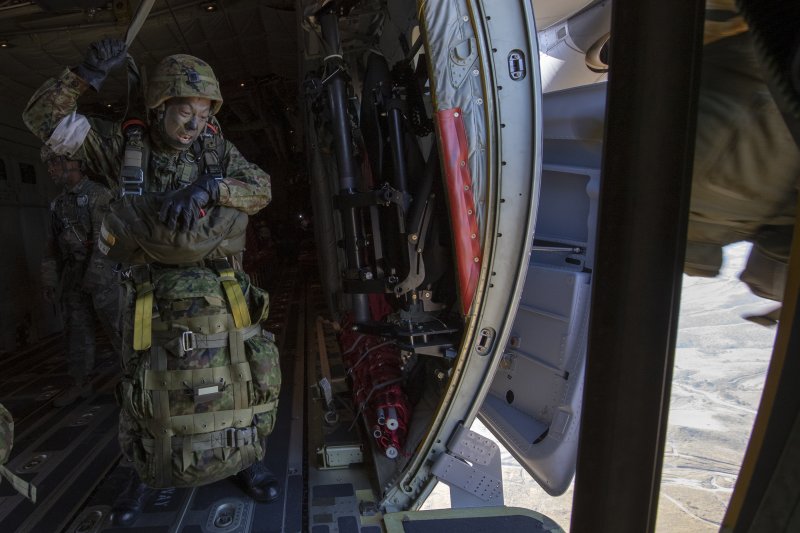A Japan Ground Self-Defense Force soldier assigned to the 1st Airborne Brigade jumps from a U.S. Air Force C-130J Super Hercules assigned to the 36th Airlift Squadron over Hiju-dai drop zone, Oita prefecture, Japan, on Nov. 4, 2018, during Keen Sword 19. Photo by Yasuo Osakabe/U.S. Air Force
Nov. 9 (UPI) -- A C-130J Super Hercules Special Operations cargo and transport plane from the U.S. Air Force 36th Airlift Squadron became the first U.S. aircraft to drop Japan Ground Self-Defense Force soldiers on Hiju-dai drop zone in Japan as part of the Keen Sword exercises.
The jump took place in Oita prefecture, Japan, on Nov. 4, during exercise Keen Sword with 120 paratroopers from the JGSDF's 1st Airborne Brigade and observers from the U.S. Army.
"It is great that we are finally able to drop JGSDF paratroopers from U.S. aircraft in Japan," Keen Sword C-130J mission commander and 36th AS C-139J pilot Capt. Jeffrey Larkin said in a press release.
"Also, this is the first time that the 36th AS will fly over Hiju-dai drop zone. This is another exciting moment for us because we can fly in an atypical environment," Larkin said.
The 36th AS and JGSDF's 1st Airborne Brigade have been conducting joint jump training during the biennial Red-Flag Alaska exercises since 2015. The jumps are meant to help interoperability and foster closer relationships between the U.S. and Japanese militaries.
"Working with the Japanese Airborne community increases bonds and friendships, and it also increases the understanding of the strategic value of both airborne communities," U.S. Army Alaska jumpmaster
Master Sgt. Nathan Greer said in the release.
The jump was one of many drills and exercises involving a total of 57,000 U.S. and Japanese servicemembers and support staff being shuttled between various sites training in a wide variety of war scenarios.
"We delivered service members, between U.S. and Japan Self-Defense Forces, from Okinawa to Misawa," said Larkin. "Also we conducted mass Container Delivery System drops at Hiju-dai."
The drops were launched out of Yokota Air Force Base in Japan.
"Everything was excellent." Greer said. "As a jumpmaster, they jumped safely and accurately. This is most important thing for jumpers, and they were professionals during the airborne operation."















